- Home
- Coffee Species: Beyond Arabica
Coffee Species: Beyond Arabica
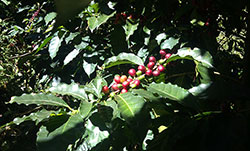 What does 100% Arabica mean? It raises questions--like Ivory Soap's claim to "99.44% pure", it makes one wonder what else might be in other, less-pure products.
What does 100% Arabica mean? It raises questions--like Ivory Soap's claim to "99.44% pure", it makes one wonder what else might be in other, less-pure products.
Truth is, it means exactly and only what it says: that the coffee beans are all of the Arabica species. The ads make it sound like that's important, though, so here in America, a lot of people have come to believe that 100% Arabica is a statement of quality, and that all other beans are inferior. Indeed, many of us don't even know other beans exist at all, much less that they're delicious!
Why should you care that there are many species of coffee?
Because only about 60% of Americans (less in other areas) actually prefer 100% Arabica coffee. It's about physiology: your taste buds are unique to you, resulting in your own unique taste. This is called your "palate". The four main coffee species, Arabica, Robusta, Excelsa, and Liberica, have radically different taste profiles. Some folks have exactly the right palate for Arabica, but many find that other species tickle their taste buds far more.
Are you a front-palate person or a back-palate person?
Broadly, people's palates can be broken into "front palate" and "back palate". Back-palate people need coffees with more depth and weight to hit the taste buds in the back of their mouth. They find Arabica thin or sour, and prefer Robusta's flavor and body. Front-palate people need coffees with brightness and lots of aroma, because they taste their coffee with the fronts of their tongues and their noses. They find Robusta flat, and prefer Arabica's lively aroma and volatile flavors.
Liberica and Excelsa don't fit as neatly into the two categories, but, by and large, back-palate people are more likely to enjoy Liberica, and front-palate folks more likely to enjoy Excelsa.
Coffee blends: more than the sum of their parts
Most people, in our experience, find a blend of multiple species to be a much more complete "picture" of coffee. Meaning, it stimulates their entire palate in a way single-source coffees usually cannot. So, especially if you're serving a crowd who might have all different palates, we recommend that you blend your coffee with at least 10% of another species. Liberica and Excelsa are particularly good blending coffees. Also, we find a very high approval rating on coffees that are mixed 50/50 Arabica and Robusta, since they cover the full palate, and are loewr in acid than Arabica alone. They are higher in caffeine due to the Robusta.
The Four Main Coffee Species
There's actually over a hundred species of coffee, and we haven't even recorded all of them yet. However, only four of them are produced commercially for drinking.
Arabica, Coffea arabica (sub-varieties include Typica, Caturra, Bourbon, Blue Mountain, and many more)
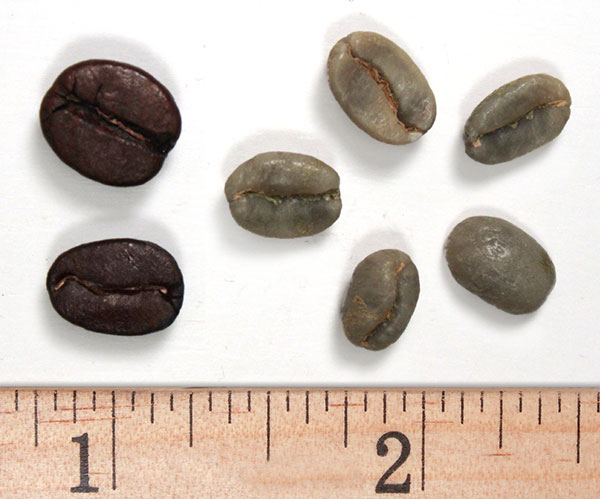
The big name in American coffee, Arabica accounts for about 48% of the world's commercial coffee production. Arabica prefers to grow in light shade at high altitude with even rainfall. Arabica trees are relatively small, and, like apple trees, can be easily kept pruned to no more than 6' tall for easy harvesting. Many commercially successful sub-varieties of Arabica have been developed over the years, including varieties with yellow or purple fruits, different environment preferences, and so on.
However, Arabica is the most delicate of the four varieties, and is vulnerable to blight. Monoculture (growing large amounts of the same species) facilitates the spread of disease and pests. Arabica's popularity also causes farmers to attempt to grow it everywhere, even places where it's not happy, and unhappy trees require more spraying and fertilizing to stay alive. As a result, Arabica is not always the most environmentally sound choice.
Flavor-wise, Arabica tends to stimulate the front palate and gets much of its appeal from its aroma. Excellent Arabicas have a highly complex flavor and aroma with many delicate layers. Poorer quality Arabicas taste thin, and the Arabica brightness turns into an unpleasant sourness or bitterness. Arabica is the most acidic coffee, a health disadvantage worsened by roasting it too dark or too light.
For the best Arabica, choose a full-bodied, lower-acid variety and give it a conservative roast. When serving your Arabica, be sensitive to the individual variety's characteristics; the delicate aromas of some Arabicas are dampened when served cold or with cream.
Robusta, Coffea caniphora

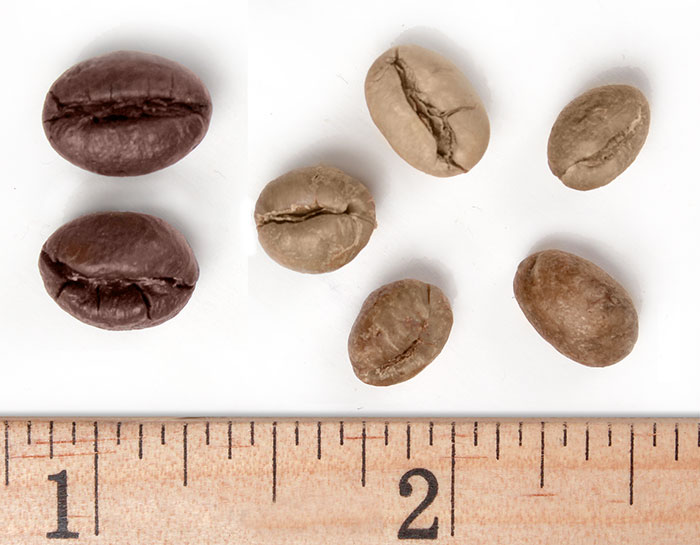
Robusta is the second biggest player in the coffee market now, and accounts for about 44% of the world crop, though at times in the past it has been the dominant species. It grows on larger trees that are better suited to heat and irregular rainfall, and can tolerate a wider range of altitudes. It has almost double the caffeine of Arabica. Since the caffeine is actually a self-defense, this means Robusta is more resistant to pests and disease than other coffee species, requiring less spraying.
Because of its vigor and ease of care, Robusta in, unfortunately, the coffee of choice in areas not well-suited to growing coffee. It can be forced to grow in extremely sub-optimal environments, even by farmers who have no idea what they're doing. As a result, the market contains some seriously awful Robusta. The coffee glut in the 1990's contained the worst of this, and is the reason modern coffee companies started the whole "100% Arabica" advertising campaign. Once this campaign started, it never stopped, because nobody ever bothers to update their knowledge base, it seems.
Flavor-wise, Robusta stimulates the back palate, giving it a heavier mouthfeel and body. Excellent Robustas are incredibly smooth, low-acid, free of bitterness, and intensely flavorful with distinct chocolate notes. Poorer quality Robustas smell flat or can even smell unpleasant, and can have odd or objectionable flavor elements, such as rubber. It's not hard to tell whether you're drinking good or bad Robusta--the difference in quality is extreme!
For the best Robusta, choose one whose description emphasizes that it was grown in a suitable area by farmers who know what they're doing. When serving Robusta, feel free to take advantage of its versatility: a good Robusta can stand up to any amount of milk and sugar (including Vietnamese-style cafe sua da!), and makes a darn fine cup of iced coffee. It's also the secret ingredient in many a fancy espresso, since Robusta enhances crema significantly.
About peaberries: The second picture on the left shows peaberry Robusta. In 5-10% of the coffee crop, the coffee cherry will contain only one seed, or bean. These single beans are round (like a pea) instead of flattened on one side the way normal twin-seeded beans are. Peaberries used to be discarded as defects, but then people realized that they have a particular intensity of flavor that comes from being a single bean. Peaberries have extra edge and a bit more caffeine. In Vietnam, the peaberry is highly prized, and their Robusta has been selectively bred to produce a higher percentage of peaberries.
Excelsa, Coffea excelsa or, more recently, Coffea liberica var. dewevrei
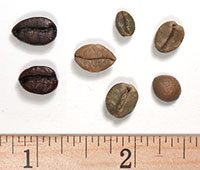
Excelsa was recently re-classified as a variety of Liberica. However, even though the plants may be taxonomically similar, the actual coffee is so dramatically different that we still think of them as entirely separate species. It accounts for about 6% of world coffee production. It grows on large, vigorous trees at medium altitudes. Many beans have a distinctive "teardrop" shape, which gives it a family resemblance to Liberica, but their average size is much smaller.
Excelsa grows mainly in Southeast Asia, where it is used as a blending coffee, especially in house blends, to add complexity and depth. Excelsa has a distinctive tart, fruity, dark, mysterious taste. In blends, it enhances the middle and back palate and lingering finish of the coffee, giving the cup more substance and power.
Brewed on its own, it is a compelling and unique coffee experience, like a good Scotch. However, like Scotch, a cup of pure Excelsa is not everyone's favorite drink. And most people don't find the aroma of Excelsa beans themselves to be attractive, although some people love it. It would be a mainstay coffee for many coffee shops if it had the intense and pleasing aroma of Arabica or Liberica, but it doesn't.
Liberica, Coffea liberica
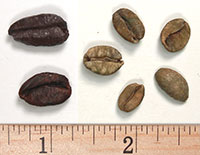
A unique and irreplacable part of our worldwide coffee heritage, Liberica is an entirely separate species of coffee, with a very distinctive taste profile. It grows on vigorous 20- 30-foot trees in jungle environments - which is fortunate, because if it weren't strong enough to grow wild, it would have gone extinct. the type of men who worked in the nearby sugar cane fields and drank a LOT of coffee to keep up their energy during their hard work. Also, it is amusing to us that these roughs enjoy sitting around the town squares in the evening, still drinking coffee and playing rough games... like... chess? Yes, it's true.
After the coffee rust in 1890 destroyed over 90% of the world's Arabica stocks, Liberica was chosen as its replacement in the Philippines by the Secretary of the Interior of the USA, since at the time, the Philippines was a US territory and the Minister of Agriculture there reported his counterpart in the USA. This was a fateful decision because it helped propel the Philippines into prominence as a coffee supplier. In fact, many of the original USA coffee brands and blends used quite a bit of Philippine coffee and Liberica. However, when the Philippines gained independence and asked the USA to remove its military bases, the USA responded by ending the importation of key crops such as rice, sugar, coconuts and coffee, plunging the Philippines into a steep decline economically. Liberica languished for decades until 1995, when a conservation effort took the last remaining 500 plants they could find and began a program of propagation and cooperative re-planting in a number of Philippine growing regions. Unfortunately, the current obsession with Arabica has resulted once again in reducing the stock and range of Liberica, as well as cross-breeding with other species to make the high bushes more accessible.
Today we struggle to find pure Liberica and support the efforts to keep it as a distinct species and irreplaceable part of the coffee genome. Liberica beans can be huge, and have the unique characteristic in which many Liberica beans are asymmetric - one side is "lower" than the other, causing a little "hook" at the bottom of the bean. It is the only bean species in the world with this irregular shape.
Its almond-shaped beans have an exceptional aroma, almost floral and fruity, while its flavor is full and slightly smokey. This is a highly polarizing coffee. Some people are not even sure it tastes like coffee, or say it tastes woody or too jungle-y; others find it revelatory. Our favorite way to use it is as a mixer. Almost any coffee can be taken to the next level by adding about 10% Liberica. The aroma it adds is incredible, a true wow-factor.
Latest Coffee Addition
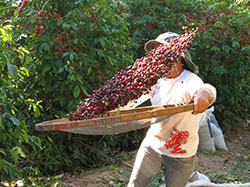
Colombian Castillo Heritage Arabica!
Coffee from the days when Colombian coffee defined American consumer tastes. Warm, rich, delicious! Read more here!
 Loading... Please wait...
Loading... Please wait...


